There are some significant changes coming to Arena soon. Drafting will be most affected. Instead of three random choices of the same rarity, we will now see three random choice of a similar power level, possibly from different rarities. Drafting should get more difficult and interesting, as there will be less “obvious” picks, where you get two weak cards paired with something very powerful. Even if the system doesn’t work perfectly at the start, they will have a lot of time to tweak it, and even if it doesn’t work properly – then it still won’t be worse than the current one, which has no real logic behind it.
You can read more about the changes here, but today we’re going to focus on the new cards coming to Arena. Each class is getting a new, unique card that will not be available in Constructed – only during the Arena drafts. Obviously, one card is not going to completely shift a balance level of classes, but we’ve already seen how one, overpowered common card (those cards should be seen as often as Basics/Commons) can push the class higher on a tier list. Let’s take a closer look at each one of them and try to determine how useful they will be during the Arena matches.
Druid – Nature's Champion
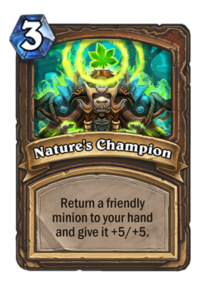
At the first glance, this feels like this slow, value-oriented card, but actually, it’s quite the contrary. It’s one of those cards that would be better in a quick draft, with lots of small minions. See, the thing is, bouncing a minion back to your hand is a negative tempo play. Giving +5/+5 for 3 mana is a positive tempo play, a buff like that would be pretty broken. But it comes with an extra cost – cost of the minions you bounce.
It basically means one thing. If you bounce back a 1-drop, and then replay it, the card is quite good. Let’s just say that you drop your Enchanted Raven on Turn 1. Then on Turn 2 you coin out this. On Turn 3, you can drop a 1 mana 7/7 as well as some 2-drop if you have one. That’s massive – unless your opponent has Silence, Sap or some had removal (which isn’t a given, it’s Arena), that’s a win right there.
Playing it on something bigger, like a 5-drop or higher, is generally not advisable. However, there are some situations in which it could come handy. One of those situations is first trading with your bigger minion, then when it’s at low health and would just die (e.g. to a ping from Mage), you can bounce it back to your hand instead. Not only you’ve buffed it, but you’ve also healed it to full.
The card gets extra value when played on Taunt, Charge or Battlecry minions, as well as minions with Divine Shield or minions with effect that needs to be stopped (e.g. summoning stuff every turn).
The biggest problem with this card, compared to the other buffs, is that it’s not immediate. Normally, if you Blessing of Kings something that can already attack, those extra stats gain “charge” – you can use it to trade up into something, push for lethal etc. This card can’t. Since the minion gets bounced to the hand, unless it has Charge, it will go through summoning sickness again.
Overall, the card is pretty situational – anything that can potentially kill your tempo is not that amazing in Arena. Generally, it will be most useful to make huge early game swings or late game value bounces. But it will be completely useless if you’re behind. Going back to that Raven example, if you’re going second, and your opponent drops his 1-drop first and trades into your Raven, then well, there’s nothing you can do. Similarly, in the late game, if your opponent controls the board, and thus dictates how the trades go, you will generally not be able to play it. That’s why I can’t rate it too highly.
Card rating: 4/10
Hunter – Deadeye
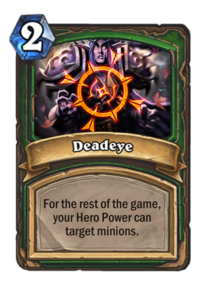
This card is like a better Shadowform (because it’s 1 mana cheaper), but in a class that needs it less. Why needs it less? Because that’s generally not how Hunter drafts go and how you play the class in Arena. Hunter is a class that relies heavily on aggression. You want a solid minion curve, some burn damage, weapons – Control Hunter is not unheard of, but a rather rare sight in Arena. Here is the thing – what’s the point of being able to choose where your Hero Power goes if you rarely play your Hero Power throughout the early / mid game (because you want to drop minions instead), and in the late game you usually want your Hero Power to go face anyway? That clock you can put with Hunter is the reason why a lot of people play it in Arena in the first place.
But, let’s not be completely pessimistic. Generally, having a Hero Power that deals 2 damage to anything is good. But realistically, for it to start gaining value, you need to utilize this effect like 3-4 times. Remember that it costs 2 mana and a card, so it’s an immediate tempo loss. Your first Deadeye + Hero Power is going to cost 4 mana for just 2 damage. Yes, it’s going to ramp up eventually, and the initial cost will blur, but like I’ve said, only after a few Hero Powers. It means that if you have a fast draft, you just won’t find use for it. However, if you draft a slower, more reactive Hunter deck, then Deadeye will certainly be useful. Just remember to not pick more than a single copy – unlike Shadowform, it won’t make your Hero Power deal 3 damage.
That’s why the good, old Steamwheedle Sniper was much better. It could still be used to clear something on the board, but it came with a 2/3 body, so dropping it on curve, or at any time, was not really a tempo loss.
Card rating: 7/10 in the right draft, 4/10 in general
Mage – Polymorph: ???
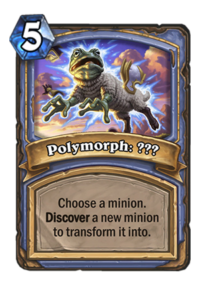
I think that this might be most fun card of all the ones revealed. And at the same time, I don’t think that it’s really good, let me explain why.
This card can serve two purposes. It might be used as a removal, or as a way to buff your own minion (or rather, transform a small guy into something big).
Let’s focus on the removal aspect right now. As a removal, it’s inferior to Polymorph in nearly every way. Not only does it cost 1 more, but it won’t be nearly as consistent. It will not be uncommon to let’s say see only 4+ mana cards. In the end, transforming a 10/10 minion into a 4/4 is still okay, but it’s not impressive for 5 mana. In terms of being a removal, this card will probably be on par with Polymorph: Boar, but the latter costs only 3 mana, which is a massive difference. The only real upside is that you can sometimes roll a minion with a downside. For example, if your opponent has a huge board, you can roll Doomsayer and it will all blow up. Or, you can roll Rattling Rascal, turn your opponent’s minion into a 2/2 and get a free 5/5 when it dies. That’s great, but given how many minions there are, it won’t consistently work that way.
But there’s more to that card. Unlike Polymorph, you can also use it on your own minions. The best case scenario is: you have something small, preferably some 1-drop like Babbling Book, you cast it on that minion and pick something big. But here’s the problem – the actual ratio of really big, powerful minions to those “small” or “medium” is pretty low. And while yes, rolling some 5-drop (which should be pretty common) won’t really be the end of the world, but will it actually be good? Definitely not. Not only you need to have a minion on the board, but you also need to sacrifice it so you have something you can transform AND play the 5 mana. Transforming anything bigger than 1-drops or 2-drops will just be too risky, as you might pay 5 mana and a card for almost no upgrade. Like, if you transform a 4-drop and roll a 5-drop, that’s like a 5 mana Evolve.
As you can see, even though the card has two uses, it doesn’t perform well in either of those roles. The worst part about it is consistency. There are simply so many minions that you have no clue how it will go, and you can’t possibly plan your plays around it. You might high-roll and turn your 1-drop into a Deathwing, but you might also want to use it to remove a 6/6 minion and turn it into a 5/5, because that was the weakest option you’ve got.
Card rating: 3/10
Paladin – Hand of Salvation
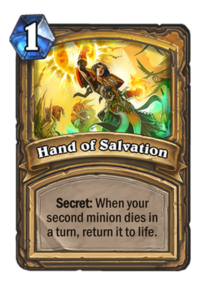
Paladin Secrets in general are… meh. There are some okay ones, like Avenge (Wild-only now), Redemption or Noble Sacrifice, but they still aren’t spectacular. I mean, you don’t expect much from a 1 mana spell, but the thing is that most of them are relatively easy to play around. You can narrow them down quite quickly without making tons of sub-optimal plays. That’s mostly because there simply aren’t many Secrets you need to play around. However, Secrets always get stronger when more of them get added to the pool.
This Secret is like a powerful Redemption with a twist. On the one hand, the twist is a downside – you need two minions on the board for it to work in the first place and you can’t set up board states in which you always revive something you want. On the other, it will make playing around Redemption much harder than it was. Normally, you’d just kill the smallest minion without Deathrattle and let it get back at 1 health – problem solved.
But now, with Hand of Salvation, it won’t be that easy. When Paladin plays a Secret, you will have no clue which one it will be. Will the FIRST or the SECOND minion get revived? It can lead to some solid mind games. Or well, just a 50/50 guess.
However, since Hand of Salvation gets the minion revived at full health, people will most likely always play around it. It’s one thing to get that Giant revived at 1 health and another to get it revived at 8. And since you can’t possibly set it up with a single minion, it won’t be as strong as it might seem.
The new Secret is cool, but I actually think that it made Redemption even stronger. Since people will nearly always play around Hand of Salvation as well as they can, it basically means that less people will play around Redemption. And you will be able to get away with playing Redemption on boards with more minions, potentially some minions you normally wouldn’t want to revive.
Card rating: 5/10
Priest – Generous Spirit
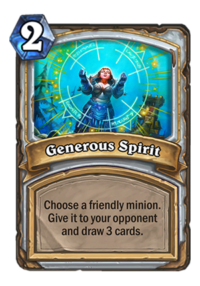
This card is really interesting. It’s like a Treachery with a massive upside – drawing 3 cards isn’t nothing. However, we need to put things into perspective. Treachery is one of the worst, if not THE worst cards in Arena. Not only do you pay 3 mana and a card, but you also give your opponent a minion.. for no gain.
In case of Generous Spirit, there will always be some gain – drawing cards. So, that alone makes the card playable. But playable doesn’t mean good.
The thing is, even when looking at the best case scenario, the card is not good. You play 1-drop and give it to your opponent with this card, and you draw 3. You’ve spent 3 mana and 2 cards to get 3 cards, which puts you at +1, which makes it a conditional Arcane Intellect – AND you give that 1-drop to your opponent. Of course, in the late game where you’re both topdecking, you don’t really mind trading that 1-drop for 3 cards. But that’s the best case scenario. You won’t always have a 1-drop at your disposal. If you make that minion a 2-drop, now the whole combo costs 4 mana, but you also give something more powerful to your opponent. 3-drops and higher are basically out of the question, unless you’re looking for a specific card or you’re ahead by a significant margin.
But anything before that, it’s a huge tempo loss. Faster Priest drafts would never want to sacrifice this much tempo, while slower Priest drafts don’t really run out of cards quickly, so it would be useful only really late into the game.
So, in your average draft, this card is just… bad. “BUT STONE!” someone might shout. “What about Doomsayer and such?” Well, here’s the thing – it’s Arena, not Constructed. Synergies don’t grow on the trees, you know. The chance to see this card and Doomsayer in the same draft is already slim, not to mention the chance to draw the combo. And if you start going all in and drafting cards that synergize with this, you will most likely make your Arena draft weaker overall. Yes, you will have the flashy combo sometimes, like playing Rattling Rascal and giving your opponent a 2/2, drawing 3 cards, and then summoning 5/5 for yourself. Amazing. But most cards like that are quite uncommon, and usually average or even bad by themselves. Cards that require specific synergy to work aren’t among the best Arena cards. Drafts are mostly about consistency, not about pulling a miraculous combo once every other game and fail in the rest of them (because that would put you at 3-3, which is not something you really want).
Card rating: 2/10, with a higher score IF your draft contains cards like Doomsayer or Bomb Squad already.
Rogue – Smoke Bomb
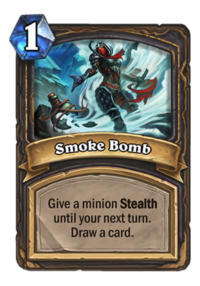
Usually cheap spells with minor effects that cycle themselves are called “cantrips” in MTG and this is a perfect example of one. Generally, cantrip cards are quite powerful for a few reasons. First one is that cycling means thinning your deck, which is very useful in any deck, which looks for specific cards (most important in combo decks, which want to find the combo as quickly as possible). That’s not a big deal in Arena, because you rarely play a heavy synergy / combo deck. However, the second advantage is more important – the card has great scaling into the late game. Your usual 1 mana spell, like let’s say Arcane Shot or Divine Strength, is good in the early game, but not so much in the late game. While the effect is still high tempo, it costs a card, and cards are limited resources. Cantrips, however, cycle themselves, so even though the effect is a bit weaker than what you normally would see on a 1 mana spell, since Another example of cantrip in Hearthstone is Power Word: Shield, while cards like Psionic Probe also share a lot of similarities with cantrips.
So, that’s the theory – cantrips are usually good, or at least above average. But it doesn’t mean that a cantrip is automatically a good card. It heavily depends on how much it costs and what’s the card’s effect. Smoke Bomb costs 1 mana, which is great. The effect is one turn of Stealth for a single minion, which places it… probably somewhere in the middle. The effect is not amazing, but it has some upsides. You can hide a high attack, but low health minion to prevent your opponent from pinging it or trading something small into it. You can hide a minion with an ongoing effect, so it gets a nearly guaranteed tick. You can also hide a strong minion to set up lethal if your opponent is low, but you suspect that they might be holding removal. And finally, you can use it to pass through a Taunt! Since there is no restriction, you can play it on your opponent’s minions. Putting a Taunt minion to Stealth basically negates his Taunt as long as the minions is hidden.
Since the card is cheap, it cycles, and the effect is pretty useful in multiple situations, I really like it. It would be much more powerful in Constructed (actually, it would be quite broken in Constructed), but it will still be a good Arena card. Especially if we see some more Stealth synergies in the upcoming expansions (for example, right now the card heavily benefits from having Shadow Sensei in your deck).
Card rating: 7/10
Shaman – Crackling Doom
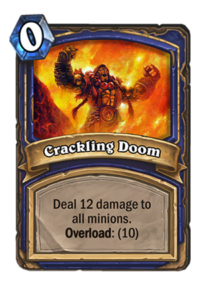
Well, that’s something really crazy. It’s like Elemental Destruction on steroids. Ele Destruction was already a solid card, and this is even better. It’s one of the best “Oh Sh*t” buttons you can ask for. 12 damage is enough to fully clear almost any board. Right now, the only common minion in the game that naturally comes with more than 12 health is Ultrasaur (Lord Jaraxxus and The Darkness too, but you see them on the board extremely rarely). Also buffing high health minions, but that’s usually counter-productive – you don’t want to put a buff on already huge minion, because you risk a single target removal. So you can safely assume that it will be a full board clear >99% of the time.
The obvious downside is skipping your next turn. That sucks, alright, no doubt about it. But since it’s a 0 mana full board clear, besides playing it, you have a FULL TURN to still develop stuff. You can drop this and let’s say play two minions. Now your opponent plays something and you trade while skipping turn. Now your opponent plays something again and yes, they have initiative, but it’s no different than clearing a big board with Volcano or Twisting Nether most of the time – you give your opponent the initiative, but you no longer stare at a big board and you’ve gained TONS of value. This card can easily get 3-4 for 1 if your opponent overextends.
Not to mention that overload removal is a thing, although not common. In Wild Arena, we still have Lava Shock (but Wild Arena will be gone before those cards go live), and in the Standard version we have Eternal Sentinel, but that will rotate out soon. It doesn’t mean that we won’t see more Overload removal in the future, and this card would pair with it perfectly. Another broken synergy, and one that will NOT rotate out soon, is obviously Snowfury Giant. Just after a single Crackling Doom, you put it down to 1 mana, so if you have both in your draft, it can be nuts.
This is the second strongest among the Arena-only cards revealed. Sure, it’s not perfect, and it’s probably a bit weaker than Volcano because of the skipping the turn part, but it will be a good card you will need to have in mind every time you play against Shaman.
Card rating: 8/10
Warlock – Bottled Madness
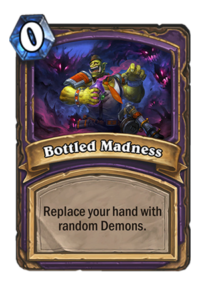
This is a really interesting effect, but I don’t think that it’s very good. First things first – average Demon is actually quite good. Some of the Demons are among the best cards in the game. But one big thing about Demons is that lots, and I mean LOTS of them come with a downside.
Two most common downsides are taking extra damage (Flame Imp, Pit Lord etc.) or discarding cards (Lakkari Felhound, Doomguard etc.). And honestly, it might make a significant part of the cards unplayable. If you’re quite low on health, it will be much harder to play any demons that damage you. On the other hand, playing the Discard ones will lead to running out of cards quite quickly. Since you’d ideally want to play this on a big hand.
Another thing is that by using it, you get -1 in terms of card advantage. Since this card does not turn into a Demon, you’re down a card. And it’s often a dead card – there are a lot of situations in which you really don’t want to use it. Like, let’s say that you’re holding your only big AoE removal in your hand (Felfire Potion or whatever). Turning it into a Demon might be a bad idea, because in case you get behind on the board, you no longer have a way to come back.
It’s actually one of the cards that is much better in a weak draft than in a strong draft. When you have a good hand (which you usually do with strong drafts) you really don’t want to change it into random Demons. But when your hand is weak, probably because your draft was weak, then random Demons would usually be better than what you have.
It’s also much better in the late game, where you can narrow your hand down to the few cards you don’t want. You just want to play the good cards first, leave a few bad cards (or 1-drops that will not be useful later in the game) in your hand and play this, turning them into something better. But that’s a quite specific scenario.
It’s an interesting card, but I don’t particularly like it. There are some drafts that might utilize it, but most of the time I’d rather stay with my hand than a bunch of random Demons. Yes, if you get 3 Voidlords you can drop back to back, that’s amazing. But you can also get a bunch of unplayable cards and just lose, because every card either damages you, discards other stuff or is just bad (*cough* Street Trickster *cough*).
Card rating: 4/10
Warrior – Blazing Longsword
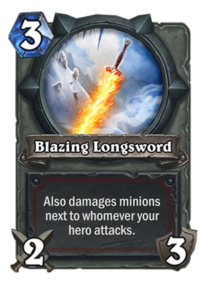
Ladies and gentlemen, this one is easily the best one among the Arena exclusives. You see, the thing is, even a 3 mana 2/3 weapon would be playable. Not great, but playable. And if you add such a powerful effect, it becomes nuts. “Cleave” effect is quite powerful in Hearthstone. For example, Cave Hydra. A normal 2/4 Beast for 3 would be… very weak. But when you add a cleave effect, you suddenly turn that into a good card. And that’s on a MINION, you know where Cleave effect is even better? On a weapon.
The reason is that, unlike with minions, you can attack with the weapon immediately. Not only that, but weapons are much more durable than minions. That 2/4 Hydra can easily get cleared by the opponent. Weapon is harder to deal with, because weapon destruction is not that common in Arena. Most of the time, you’re going to swing 3 times with it, and that’s great.
And why is it so strong, you might ask? Well, it reminds me of a Hunter card – Powershot. Which, again, is a really good card. On turn 3, there are rarely more than 3 minions on the board anyway. It’s also a bit similar to Volcanic Potion – Volcanic Potion’s upside is that it can affect the whole board, but the downside is that it hits your own minions too.
But unlike those two, this weapon can swing… three times. At the price of your health, of course, but that is a MASSIVE tempo boost. It’s true that after the first strike, your opponent will try to play around it, but it doesn’t change the fact that it will still be super useful. It basically prevents him from flooding the board with small minions. Or, a Paladin or Shaman can’t often even play their Hero Powers, as it would mean that you can hit it and attack something bigger at the same time.
This is a great weapon, and probably the best Warrior weapon right now after the nerf of Fiery War Axe. Well, maybe Death's Bite is still a bit stronger, but Death’s Bite is Wild-only, so it will soon disappear. This weapon is on par with weapons like Gorehowl or Fool's Bane, which are some of the best Warrior cards in the Arena. And since it’s common, we should see it quite often.
Card rating: 9/10
Closing
That’s all folks. Even though some of the cards are clearly worse, while others are clearly better, I really like the fact that they are adding exclusive cards to the Arena. If they add more, it will make the mode feel even more different from Constructed, which is great. I also dig the changes to drafting. It all might reignite my passion for the Arena – it used to be my #1 format two or three years back, but it got quite boring after a while, because not much was changing.
And what do you think about the new Arena cards, and the changes in general? Do you agree with my ratings? If not, how would you rate some of those cards instead? Let me know in the comments, and until next time!

Hi there!
Good analysis, thank you for it.
Some thoughts:
Nature’s Champion – Just wondering why you didn’t mention Battlecry?
Hand of Salvation – Maybe I have some screwed up logic here: If you absolutely need to kill 2 minions, start by killing the bigger one. If you don’t have to kill 2 minions, just kill the smallest non-deathrattle minion. Isn’t it just that simple and all the ‘playing around’ you need regarding HoS and Redemption?
And I really hope that some of those cards are not seen as often as Basics or Commons (Crackling Doom and Blazing Longsword, to be exact).
Happy gaming!
About Nature’s Champion – I forgot Yes, it also works well if you want to replay Battlecries. However, the thing is that relevant Battlecry minions tend to be expensive anyway, which still makes small minions the best targets. But I’ll mention Battlecries!
Yes, it also works well if you want to replay Battlecries. However, the thing is that relevant Battlecry minions tend to be expensive anyway, which still makes small minions the best targets. But I’ll mention Battlecries!
About Hand of Salvataion, well, it’s not always that easy. Just to give you a random example, your opponent has Bone Drake and some small minion on the board + a Secret. Now, which one do you kill first? If you kill Bone Drake first to play around Hand of Salvation, and it turns out to be Redemption, it sucks, because they get a 6/1 back and another Dragon for free. Now if you kill the small minion first, it sucks if it turned out to be Hand of Salvation.
Yes, sometimes you can leave that Bone Drake up, but that’s often already a win for your opponent, as they get either 6 damage or can dictate how the trading goes now.
There will be situations like that. Sometimes it’s impossible to play around both at the same time, and you have to pick which one you play around. With Redemption, you ALWAYS started by clearing the small minion without Deathrattle, now it might not be the best option.
Not to mention that it might mess up with your AoE turn. Let’s say that your opponent has some Deathrattle/Stealth/whatever minion played first and you want to AoE down the whole board. Right now when you see a Secret, you try to proc the Redemption first by killing something small (usually pinging it) and THEN AoE, so the Deathrattle/Stealth one doesn’t get revived. Right now it might not be that obvious. If it’s Redemption, then clearing minion first is the right play – if it’s Hand of Salvation, then (depending on what was the second minion on the board), it might be better to AoE everything.
I mean, sometimes playing around them will be easy, but there will be some situations in which you will have to think hard (or just go for whatever option screws you less). It will make Redemption stronger, because people will usually put a higher priority on playing around Hand of Salvation, as it’s more deadly if it works.
Or maybe I’m just overcomplicating it
Regarding overcomplicated thinking: I guess we’ll just have to wait and see.